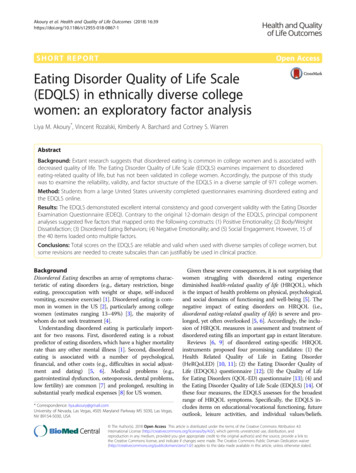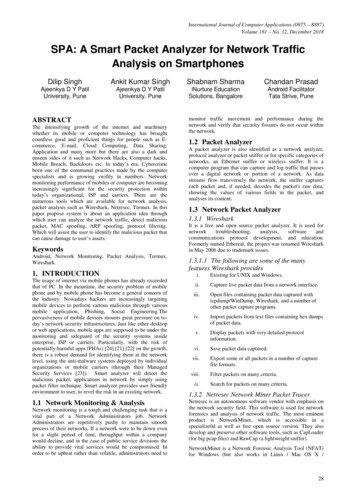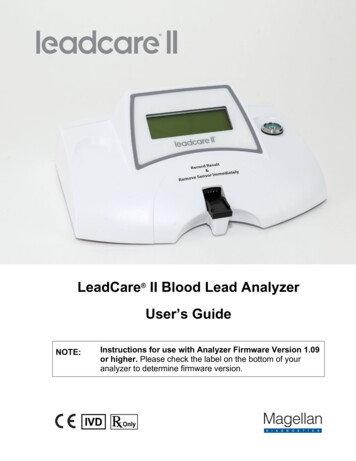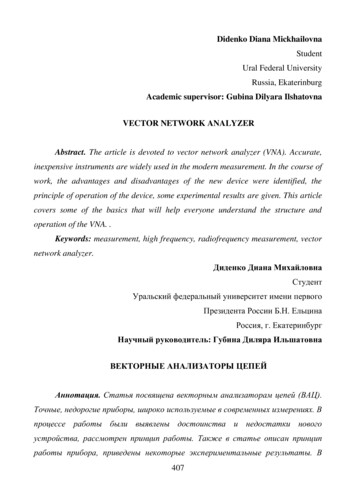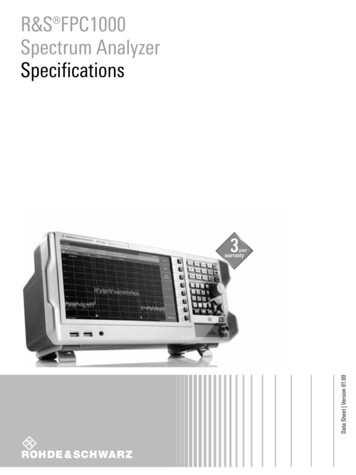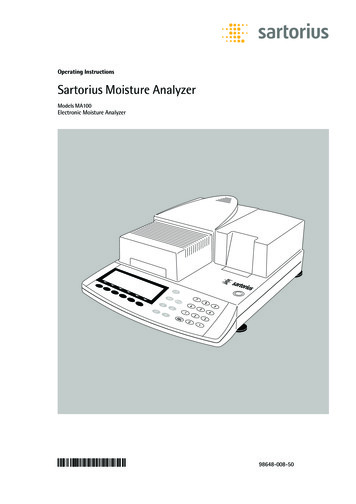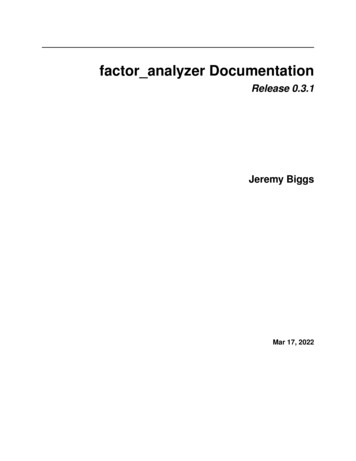
Transcription
factor analyzer DocumentationRelease 0.3.1Jeremy BiggsMar 17, 2022
.1 factor analyzer package . . . . . . . . . . . . . . . . . . . . . . . . . . . . . . . . . . . . . . . . .774Indices and tables25Python Module Index27Index29i
ii
factor analyzer Documentation, Release 0.3.1This is a Python module to perform exploratory and factor analysis (EFA), with several optional rotations. It alsoincludes a class to perform confirmatory factor analysis (CFA), with certain pre-defined constraints. In expoloratoryfactor analysis, factor extraction can be performed using a variety of estimation techniques. The factor analyzerpackage allows users to perfrom EFA using either (1) a minimum residual (MINRES) solution, (2) a maximum likelihood (ML) solution, or (3) a principal factor solution. However, CFA can only be performe using an ML solution.Both the EFA and CFA classes within this package are fully compatible with scikit-learn. Portions of this code areported from the excellent R library psych, and the sem package provided inspiration for the CFA class.Contents:1
factor analyzer Documentation, Release 0.3.12Contents:
CHAPTER1DescriptionExploratory factor analysis (EFA) is a statistical technique used to identify latent relationships among sets of observedvariables in a dataset. In particular, EFA seeks to model a large set of observed variables as linear combinations ofsome smaller set of unobserved, latent factors. The matrix of weights, or factor loadings, generated from an EFAmodel describes the underlying relationships between each variable and the latent factors.Confirmatory factor analysis (CFA), a closely associated technique, is used to test an a priori hypothesis about latentrelationships among sets of observed variables. In CFA, the researcher specifies the expected pattern of factor loadings(and possibly other constraints), and fits a model according to this specification.Typically, a number of factors (K) in an EFA or CFA model is selected such that it is substantially smaller than thenumber of variables. The factor analysis model can be estimated using a variety of standard estimation methods,including but not limited MINRES or ML.Factor loadings are similar to standardized regression coefficients, and variables with higher loadings on a particularfactor can be interpreted as explaining a larger proportion of the variation in that factor. In the case of EFA, factorloading matrices are usually rotated after the factor analysis model is estimated in order to produce a simpler, moreinterpretable structure to identify which variables are loading on a particular factor.Two common types of rotations are:1. The varimax rotation, which rotates the factor loading matrix so as to maximize the sum of the variance ofsquared loadings, while preserving the orthogonality of the loading matrix.2. The promax rotation, a method for oblique rotation, which builds upon the varimax rotation, but ultimatelyallows factors to become correlated.This package includes a factor analyzer module with a stand-alone FactorAnalyzer class. The class includes fit() and transform() methods that enable users to perform factor analysis and score new data using thefitted factor model. Users can also perform optional rotations on a factor loading matrix using the Rotator class.The following rotation options are available in both FactorAnalyzer and Rotator:(a) varimax (orthogonal rotation)(b) promax (oblique rotation)(c) oblimin (oblique rotation)3
factor analyzer Documentation, Release 0.3.1(d) oblimax (orthogonal rotation)(e) quartimin (oblique rotation)(f) quartimax (orthogonal rotation)(g) equamax (orthogonal rotation)(h) geomin obl (oblique rotation)(i) geomin ort (orthogonal rotation)In adddition, the package includes a confirmatory factor analyzer module with a stand-aloneConfirmatoryFactorAnalyzer class. The class includes fit() and transform() that enable users toperform confirmatory factor analysis and score new data using the fitted model. Performing CFA requires users tospecify in advance a model specification with the expected factor loading relationships. This can be done using theModelSpecificationParser class.4Chapter 1. Description
CHAPTER2Requirements Python 3.4 or higher numpy pandas scipy scikit-learn5
factor analyzer Documentation, Release 0.3.16Chapter 2. Requirements
CHAPTER3InstallationYou can install this package via pip with: pip install factor analyzerAlternatively, you can install via conda with: conda install -c ets factor analyzer3.1 factor analyzer package3.1.1 factor analyzer.analyze Module3.1.2 factor analyzer.factor analyzer ModuleFactor analysis using MINRES or ML, with optional rotation using Varimax or Promax.author Jeremy Biggs (jbiggs@ets.org)author Nitin Madnani (nmadnani@ets.org)organization Educational Testing Servicedate 2021-10-18class factor analyzer.factor analyzer.FactorAnalyzer(n factors 3,rotation ’promax’,method ’minres’,use smc True,is corr matrix False,bounds (0.005,1),impute ’median’,svd method ’randomized’,rotation kwargs None)Bases: sklearn.base.BaseEstimator, sklearn.base.TransformerMixin7
factor analyzer Documentation, Release 0.3.1A FactorAnalyzer class, which (1) Fits a factor analysis model using minres, maximum likelihood, or principal factor extraction andreturns the loading matrix(2) Optionally performs a rotation, with method including:(a) varimax (orthogonal rotation)(b) promax (oblique rotation)(c) oblimin (oblique rotation)(d) oblimax (orthogonal rotation)(e) quartimin (oblique rotation)(f) quartimax (orthogonal rotation)(g) equamax (orthogonal rotation)Parameters n factors (int, optional) – The number of factors to select. Defaults to 3. rotation (str, optional) – The type of rotation to perform after fitting the factoranalysis model. If set to None, no rotation will be performed, nor will any associated Kaisernormalization.Methods include:(a) varimax (orthogonal rotation)(b) promax (oblique rotation)(c) oblimin (oblique rotation)(d) oblimax (orthogonal rotation)(e) quartimin (oblique rotation)(f) quartimax (orthogonal rotation)(g) equamax (orthogonal rotation)Defaults to ‘promax’. method ({'minres', 'ml', 'principal'}, optional) – The fitting methodto use, either MINRES or Maximum Likelihood. Defaults to ‘minres’. use smc (bool, optional) – Whether to use squared multiple correlation as startingguesses for factor analysis. Defaults to True. bounds (tuple, optional) – The lower and upper bounds on the variables for “LBFGS-B” optimization. Defaults to (0.005, 1). impute ({'drop', 'mean', 'median'}, optional) – If missing values arepresent in the data, either use list-wise deletion (‘drop’) or impute the column median (‘median’) or column mean (‘mean’). Defaults to ‘median’ use corr matrix (bool, optional) – Set to true if the data is the correlation matrix. Defaults to False. svd method ({‘lapack’, ‘randomized’}) – The SVD method to use whenmethod 'principal'. If ‘lapack’, use standard SVD from scipy.linalg. If ‘randomized’, use faster randomized svd function from scikit-learn. The latter should only8Chapter 3. Installation
factor analyzer Documentation, Release 0.3.1be used if the number of columns is greater than or equal to the number of rows in in thedataset. Defaults to ‘randomized’ optional (rotation kwargs,) – Additional key word arguments are passed to therotation method.loadingsThe factor loadings matrix. Default to None, if fit() has not been called.Type numpy arraycorrThe original correlation matrix. Default to None, if fit() has not been called.Type numpy arrayrotation matrixThe rotation matrix, if a rotation has been performed.Type numpy arraystructureThe structure loading matrix. This only exists if the rotation is promax.Type numpy array or NonepsiThe factor correlations matrix. This only exists if the rotation is oblique.Type numpy array or NoneNotesThis code was partly derived from the excellent R package psych.References[1] amples import pandas as pd from factor analyzer import FactorAnalyzer df features pd.read csv('tests/data/test02.csv') fa FactorAnalyzer(rotation None) fa.fit(df features)FactorAnalyzer(bounds (0.005, 1), impute 'median', is corr matrix False,method 'minres', n factors 3, rotation None, rotation kwargs {},use smc True) fa.loadingsarray([[-0.12991218, 0.16398154, 0.73823498],[ 0.03899558, 0.04658425, 0.01150343],[ 0.34874135, 0.61452341, -0.07255667],[ 0.45318006, 0.71926681, -0.07546472],[ 0.36688794, 0.44377343, -0.01737067],[ 0.74141382, -0.15008235, 0.29977512],[ 0.741675 , -0.16123009, -0.20744495],(continues on next page)3.1. factor analyzer package9
factor analyzer Documentation, Release 0.3.1(continued from previous page)[ 0.82910167, -0.20519428, 0.04930817],[ 0.76041819, -0.23768727, -0.1206858 ],[ 0.81533404, -0.12494695, 0.17639683]]) fa.get communalities()array([0.588758 , 0.00382308, 0.50452402, 0.72841183, 0.33184336,0.66208428, 0.61911036, 0.73194557, 0.64929612, 0.71149718])fit(X, y None)Fit the factor analysis model using either minres, ml, or principal solutions. By default, use SMC asstarting guesses.Parameters X (array-like) – The data to analyze. y (ignored) –Examples import pandas as pd from factor analyzer import FactorAnalyzer df features pd.read csv('tests/data/test02.csv') fa FactorAnalyzer(rotation None) fa.fit(df features)FactorAnalyzer(bounds (0.005, 1), impute 'median', is corr matrix False,method 'minres', n factors 3, rotation None, rotation kwargs {},use smc True) fa.loadingsarray([[-0.12991218, 0.16398154, 0.73823498],[ 0.03899558, 0.04658425, 0.01150343],[ 0.34874135, 0.61452341, -0.07255667],[ 0.45318006, 0.71926681, -0.07546472],[ 0.36688794, 0.44377343, -0.01737067],[ 0.74141382, -0.15008235, 0.29977512],[ 0.741675 , -0.16123009, -0.20744495],[ 0.82910167, -0.20519428, 0.04930817],[ 0.76041819, -0.23768727, -0.1206858 ],[ 0.81533404, -0.12494695, 0.17639683]])get communalities()Calculate the communalities, given the factor loading matrix.Returns communalities – The communalities from the factor loading matrix.Return type numpy arrayExamples import pandas as pd from factor analyzer import FactorAnalyzer df features pd.read csv('tests/data/test02.csv') fa FactorAnalyzer(rotation None) fa.fit(df features)FactorAnalyzer(bounds (0.005, 1), impute 'median', is corr matrix False,method 'minres', n factors 3, rotation None, rotation kwargs {},(continues on next page)10Chapter 3. Installation
factor analyzer Documentation, Release 0.3.1(continued from previous page)use smc True) fa.get communalities()array([0.588758 , 0.00382308, 0.50452402, 0.72841183, 0.33184336,0.66208428, 0.61911036, 0.73194557, 0.64929612, 0.71149718])get eigenvalues()Calculate the eigenvalues, given the factor correlation matrix.Returns original eigen values (numpy array) – The original eigen values common factor eigen values (numpy array) – The common factor eigen valuesExamples import pandas as pd from factor analyzer import FactorAnalyzer df features pd.read csv('tests/data/test02.csv') fa FactorAnalyzer(rotation None) fa.fit(df features)FactorAnalyzer(bounds (0.005, 1), impute 'median', is corr matrix False,method 'minres', n factors 3, rotation None, rotation kwargs {},use smc True) fa.get eigenvalues()(array([ 3.51018854, 1.28371018, 0.73739507, 0.1334704 , 0.03445558,0.0102918 , -0.00740013, -0.03694786, -0.05959139, -0.07428112]),array([ 3.51018905, 1.2837105 , 0.73739508, 0.13347082, 0.03445601,0.01029184, -0.0074, -0.03694834, -0.05959057, -0.07428059]))get factor variance()Calculate the factor variance information, including variance, proportional variance and cumulative variance for each factorReturns variance (numpy array) – The factor variances. proportional variance (numpy array) – The proportional factor variances. cumulative variances (numpy array) – The cumulative factor variances.Examples import pandas as pd from factor analyzer import FactorAnalyzer df features pd.read csv('tests/data/test02.csv') fa FactorAnalyzer(rotation None) fa.fit(df features)FactorAnalyzer(bounds (0.005, 1), impute 'median', is corr matrix False,method 'minres', n factors 3, rotation None, rotation kwargs {},use smc True) # 1. Sum of squared loadings (variance). # 2. Proportional variance. # 3. Cumulative variance fa.get factor variance()(continues on next page)3.1. factor analyzer package11
factor analyzer Documentation, Release 0.3.1(continued from previous page)(array([3.51018854, 1.28371018, 0.73739507]),array([0.35101885, 0.12837102, 0.07373951]),array([0.35101885, 0.47938987, 0.55312938]))get uniquenesses()Calculate the uniquenesses, given the factor loading matrix.Returns uniquenesses – The uniquenesses from the factor loading matrix.Return type numpy arrayExamples import pandas as pd from factor analyzer import FactorAnalyzer df features pd.read csv('tests/data/test02.csv') fa FactorAnalyzer(rotation None) fa.fit(df features)FactorAnalyzer(bounds (0.005, 1), impute 'median', is corr matrix False,method 'minres', n factors 3, rotation None, rotation kwargs {},use smc True) fa.get uniquenesses()array([0.411242 , 0.99617692, 0.49547598, 0.27158817, 0.66815664,0.33791572, 0.38088964, 0.26805443, 0.35070388, 0.28850282])transform(X)Get the factor scores for new data set.Parameters X (array-like, shape (n samples, n features)) – The data toscore using the fitted factor model.Returns X new – The latent variables of X.Return type numpy array, shape (n samples, n components)Examples import pandas as pd from factor analyzer import FactorAnalyzer df features pd.read csv('tests/data/test02.csv') fa FactorAnalyzer(rotation None) fa.fit(df features)FactorAnalyzer(bounds (0.005, 1), impute 'median', is corr matrix False,method 'minres', n factors 3, rotation None, rotation kwargs {},use smc True) fa.transform(df features)array([[-1.05141425, 0.57687826, 0.1658788 ],[-1.59940101, 0.89632125, 0.03824552],[-1.21768164, -1.16319406, 0.57135189],.,[ 0.13601554, 0.03601086, 0.28813877],[ 1.86904519, -0.3532394 , -0.68170573],[ 0.86133386, 0.18280695, -0.79170903]])factor analyzer.factor analyzer.calculate bartlett sphericity(x)Test the hypothesis that the correlation matrix is equal to the identity matrix.identity12Chapter 3. Installation
factor analyzer Documentation, Release 0.3.1H0: The matrix of population correlations is equal to I. H1: The matrix of population correlations is not equalto I.The formula for Bartlett’s Sphericity test is: 1 * (𝑛 1 ((2𝑝 5)/6)) * 𝑙𝑛(𝑑𝑒𝑡(𝑅))Where R det(R) is the determinant of the correlation matrix, and p is the number of variables.Parameters x (array-like) – The array from which to calculate sphericity.Returns statistic (float) – The chi-square value. p value (float) – The associated p-value for the test.factor analyzer.factor analyzer.calculate kmo(x)Calculate the Kaiser-Meyer-Olkin criterion for items and overall. This statistic represents the degree to whicheach observed variable is predicted, without error, by the other variables in the dataset. In general, a KMO 0.6is considered inadequate.Parameters x (array-like) – The array from which to calculate KMOs.Returns kmo per variable (numpy array) – The KMO score per item. kmo total (float) – The KMO score overall.3.1.3 factor analyzer.confirmatory factor analyzer ModuleConfirmatory factor analysis using machine learning methods.author Jeremy Biggs (jbiggs@ets.org)author Nitin Madnani (nmadnani@ets.org)organization Educational Testing Servicedate 2021-10-18class factor analyzer.confirmatory factor analyzer.ConfirmatoryFactorAnalyzer(specification Nonen obs None,is cov matrix Falbounds None,max iter 200,tol None,impute ’median’,disp True)Bases: sklearn.base.BaseEstimator, sklearn.base.TransformerMixinA ConfirmatoryFactorAnalyzer class, which fits a confirmatory factor analysis model using maximum likelihood.Parameters specification (ModelSpecificaition object or None, optional) –A model specification. This must be a ModelSpecificaiton object or None. If None,the ModelSpecification will be generated assuming that n factors n variables, and thatall variables load on all factors. Note that this could mean the factor model is not identified,and the optimization could fail. Defaults to None.3.1. factor analyzer package13
factor analyzer Documentation, Release 0.3.1 n obs (int or None, optional) – The number of observations in the original dataset. If this is not passed and is cov matrix True, then an error will be raised. Defaults toNone. is cov matrix (bool, optional) – Whether the input X is a covariance matrix. IfFalse, assume it is the full data set. Defaults to False. bounds (list of tuples or None, optional) – A list of minimum and maximum boundaries for each element of the input array. This must equal x0, which is the inputarray from your parsed and combined model specification. The length is:((n factors * n variables) n variables n factors (((n factors * n factors) n factors) // 2)If None, nothing will be bounded. Defaults to None. max iter (int, optional) – The maximum number of iterations for the optimizationroutine. Defaults to 200. tol (float or None, optional) – The tolerance for convergence. Defaults toNone. disp (bool, optional) – Whether to print the scipy optimization fmin message tostandard output. Defaults to True.Raises ValueError – If is cov matrix is True, and n obs is not provided.modelThe model specification object.Type ModelSpecificationloadingsThe factor loadings matrix.Type numpy arrayerror varsThe error variance matrixType numpy arrayfactor varcovsThe factor covariance matrix.Type numpy arraylog likelihoodThe log likelihood from the optimization routine.Type floataicThe Akaike information criterion.Type floatbicThe Bayesian information criterion.Type float14Chapter 3. Installation
factor analyzer Documentation, Release 0.3.1Examples import pandas as pd from factor analyzer import ser) X pd.read csv('tests/data/test11.csv') model dict {"F1": ["V1", "V2", "V3", "V4"],."F2": ["V5", "V6", "V7", "V8"]} model spec ModelSpecificationParser.parse model specification from dict(X, model dict) cfa ConfirmatoryFactorAnalyzer(model spec, disp False) cfa.fit(X.values) cfa.loadingsarray([[0.99131285, 0.],[0.46074919, 0.],[0.3502267 , 0.],[0.58331488, 0.],[0., 0.98621042],[0., 0.73389239],[0., 0.37602988],[0., 0.50049507]]) cfa.factor varcovsarray([[1., 0.17385704],[0.17385704, 1.]]) cfa.get standard errors()(array([[0.06779949, 0.],[0.04369956, 0.],[0.04153113, 0.],[0.04766645, 0.],[0., 0.06025341],[0., 0.04913149],[0., 0.0406604 ],[0., 0.04351208]]),array([0.11929873, 0.05043616, 0.04645803, 0.05803088,0.10176889, 0.06607524, 0.04742321, 0.05373646])) cfa.transform(X.values)array([[-0.46852166, -1.08708035],[ 2.59025301, 1.20227783],[-0.47215977, 2.65697245],.,[-1.5930886 , -0.91804114],[ 0.19430887, 0.88174818],[-0.27863554, -0.7695101 ]])fit(X, y None)Perform confirmatory factor analysis.Parameters X (array-like) – The data to use for confirmatory factor analysis. If this is just acovariance matrix, make sure is cov matrix was set to True. y (ignored) –Raises ValueError – If the specification is not None or a ModelSpecification object AssertionError – If is cov matrix True and the matrix is not square. AssertionError – If len(bounds) ! len(x0)3.1. factor analyzer package15
factor analyzer Documentation, Release 0.3.1Examples import pandas as pd from factor analyzer import ser) X pd.read csv('tests/data/test11.csv') model dict {"F1": ["V1", "V2", "V3", "V4"],."F2": ["V5", "V6", "V7", "V8"]} model spec ModelSpecificationParser.parse model specification from dict(X, model dict) cfa ConfirmatoryFactorAnalyzer(model spec, disp False) cfa.fit(X.values) cfa.loadingsarray([[0.99131285, 0.],[0.46074919, 0.],[0.3502267 , 0.],[0.58331488, 0.],[0., 0.98621042],[0., 0.73389239],[0., 0.37602988],[0., 0.50049507]])get model implied cov()Get the model-implied covariance matrix (sigma), if the model has been estimated.Returns model implied cov – The model-implied covariance matrix.Return type numpy arrayExamples import pandas as pd from factor analyzer import ser) X pd.read csv('tests/data/test11.csv') model dict {"F1": ["V1", "V2", "V3", "V4"],."F2": ["V5", "V6", "V7", "V8"]} model spec ModelSpecificationParser.parse model specification from dict(X, model dict) cfa ConfirmatoryFactorAnalyzer(model spec, disp False) cfa.fit(X.values) cfa.get model implied cov()array([[2.07938612, 0.45674659, 0.34718423, 0.57824753, 0.16997013,0.12648394, 0.06480751, 0.08625868],[0.45674659, 1.16703337, 0.16136667, 0.26876186, 0.07899988,0.05878807, 0.03012168, 0.0400919 ],[0.34718423, 0.16136667, 1.07364855, 0.20429245, 0.06004974,0.04468625, 0.02289622, 0.03047483],[0.57824753, 0.26876186, 0.20429245, 1.28809317, 0.10001495,0.07442652, 0.03813447, 0.05075691],[0.16997013, 0.07899988, 0.06004974, 0.10001495, 2.0364391 ,0.72377232, 0.37084458, 0.49359346],[0.12648394, 0.05878807, 0.04468625, 0.07442652, 0.72377232,1.48080077, 0.27596546, 0.36730952],[0.06480751, 0.03012168, 0.02289622, 0.03813447, 0.37084458,0.27596546, 1.11761918, 0.1882011 ],(continues on next page)16Chapter 3. Installation
factor analyzer Documentation, Release 0.3.1(continued from previous page)[0.08625868, 0.0400919 , 0.03047483, 0.05075691, 0.49359346,0.36730952, 0.1882011 , 1.28888233]])get standard errors()Get the standard errors from the implied covariance matrix and implied means.Returns loadings se (numpy array) – The standard errors for the factor loadings. error vars se (numpy array) – The standard errors for the error variances.Examples import pandas as pd from factor analyzer import ser) X pd.read csv('tests/data/test11.csv') model dict {"F1": ["V1", "V2", "V3", "V4"],."F2": ["V5", "V6", "V7", "V8"]} model spec ModelSpecificationParser.parse model specification from dict(X, model dict) cfa ConfirmatoryFactorAnalyzer(model spec, disp False) cfa.fit(X.values) cfa.get standard errors()(array([[0.06779949, 0.],[0.04369956, 0.],[0.04153113, 0.],[0.04766645, 0.],[0., 0.06025341],[0., 0.04913149],[0., 0.0406604 ],[0., 0.04351208]]),array([0.11929873, 0.05043616, 0.04645803, 0.05803088,0.10176889, 0.06607524, 0.04742321, 0.05373646]))transform(X)Get the factor scores for new data set.Parameters X (array-like, shape (n samples, n features)) – The data toscore using the fitted factor model.Returns scores – The latent variables of X.Return type numpy array, shape (n samples, n components)Examples import pandas as pd from factor analyzer import ser) X pd.read csv('tests/data/test11.csv') model dict {"F1": ["V1", "V2", "V3", "V4"],."F2": ["V5", "V6", "V7", "V8"]} model spec ModelSpecificationParser.parse model specification from dict(X, model dict)(continues on next page)3.1. factor analyzer package17
factor analyzer Documentation, Release 0.3.1(continued from previous page) cfa ConfirmatoryFactorAnalyzer(model spec, disp False) cfa.fit(X.values) cfa.transform(X.values)array([[-0.46852166, -1.08708035],[ 2.59025301, 1.20227783],[-0.47215977, 2.65697245],.,[-1.5930886 , -0.91804114],[ 0.19430887, 0.88174818],[-0.27863554, -0.7695101 cles/PMC6157408/class factor analyzer.confirmatory factor analyzer.ModelSpecification(loadings,n factors,n variables,factor names None,variable names None)Bases: objectA class to encapsulate the model specification for CFA. This class contains a number of specification propertiesthat are used in the CFA procedure.Parameters loadings (array-like) – The factor loadings specification. error vars (array-like) – The error variance specification factor covs (array-like) – The factor covariance specification. factor names (list of str or None) – A list of factor names, if available. Defaults to None. variable names (list of str or None) – A list of variable names, if available.Defaults to None.loadingsThe factor loadings specification.Type numpy arrayerror varsThe error variance specificationType numpy arrayfactor covsThe factor covariance specification.Type numpy arrayn factorsThe number of factors.Type int18Chapter 3. Installation
factor analyzer Documentation, Release 0.3.1n variablesThe number of variables.Type intn lower diagThe number of elements in the factor covs array, which is equal to the lower diagonal of the factor covariance matrix.Type intloadings freeThe indexes of “free” factor loading parameters.Type numpy arrayerror vars freeThe indexes of “free” error variance parameters.Type numpy arrayfactor covs freeThe indexes of “free” factor covariance parameters.Type numpy arrayfactor namesA list of factor names, if available.Type list of str or Nonevariable namesA list of variable names, if available.Type list of str or Nonecopy()error varserror vars freefactor covsfactor covs freefactor namesget model specification as dict()Get the model specification as a dictionary.Returns model specification – The model specification keys and values, as a dictionary.Return type dictloadingsloadings freen factorsn lower diagn variablesvariable names3.1. factor analyzer package19
factor analyzer Documentation, Release 0.3.1class factor analyzer.confirmatory factor analyzer.ModelSpecificationParserBases: objectA class to generate the model specification for CFA. This class includes two static methods to generate theModelSpecification object from either a dictionary or a numpy array.static parse model specification from array(X, specification None)Generate the model specification from an array. The columns should correspond to the factors, and therows should correspond to the variables. If this method is used to create the ModelSpecification,then no factor names and variable names will be added as properties to that object.Parameters X (array-like) – The data set that will be used for CFA. specification (array-like or None) – An array with the loading details. IfNone, the matrix will be created assuming all variables load on all factors. Defaults toNone.Returns A model specification objectReturn type ModelSpecificationRaises ValueError – If specification is not in the expected format.Examples import pandas as pd import numpy as np from factor analyzer import ser) X pd.read csv('tests/data/test11.csv') model array np.array([[1, 1, 1, 1, 0, 0, 0, 0], [0, 0, 0, 0, 1, 1, 1, 1]]) model spec ModelSpecificationParser.parse model specification from array(X,. model array)static parse model specification from dict(X, specification None)Generate the model specification from a dictionary. The keys in the dictionary should be the factor names,and the values should be the feature names. If this method is used to create the ModelSpecification,then factor names and variable names will be added as properties to that object.Parameters X (array-like) – The data set that will be used for CFA. specification (dict or None) – A dictionary with the loading details. If None,the matrix will be created assuming all variables load on all factors. Defaults to None.Returns A model specification objectReturn type ModelSpecificationRaises ValueError – If specification is not in the expected format.20Chapter 3. Installation
factor analyzer Documentation, Release 0.3.1Examples import pandas as pd from factor analyzer import ser) X pd.read csv('tests/data/test11.csv') model dict {"F1": ["V1", "V2", "V3", "V4"],."F2": ["V5", "V6", "V7", "V8"]} model spec ModelSpecificationParser.parse model specification from dict(X, model dict)3.1.4 factor analyzer.rotator ModuleClass to perform various rotations of factor loading matrices.author Jeremy Biggs (jbiggs@ets.org)author Nitin Madnani (nmadnani@ets.org)organization Educational Testing Servicedate 2021-10-18class factor analyzer.rotator.Rotator(method ’varimax’,normalize True,power 4,kappa 0, gamma 0, delta 0.01, max iter 500,tol 1e-05)Bases: sklearn.base.BaseEstimatorThe Rotator class takes an (unrotated) factor loading matrix and performs one of several rotations.Parameters method (str, optional) –The factor rotation method. Options include:(a) varimax (orthogonal rotation)(b) promax (oblique rotation)(c) oblimin (oblique rotation)(d) oblimax (orthogonal rotation)(e) quartimin (oblique rotation)(f) quartimax (orthogonal rotation)(g) equamax (orthogonal rotation)(h) geomin obl (oblique rotation)(i) geomin ort (orthogonal rotation)Defaults to ‘varimax’. normalize (bool or None, optional) – Whether to perform Kaiser normalization and de-normalization prior to and following rotation. Used for varimax and promaxrotations. If None, default for promax is False, and default for varimax is True. Defaults toNone. power (int, optional) – The power to which to raise the promax loadings (minus 1).Numbers should generally range form 2 to 4. Defaults to 4.3.1. factor analyzer package21
factor analyzer Documentation, Release 0.3.1 kappa (int, optional) – The kappa value for the equamax objective. Ignored if themethod is not ‘equamax’. Defaults to 0. gamma (int, optional) – The gamma level for the oblimin objective. Ignored if themethod is not ‘oblimin’. Defaults to 0. delta (float, optional) –The delta level for geomin objectives. Ignore
The factor analysis model can be estimated using a variety of standard estimation methods, including but not limited MINRES or ML. Factor loadings are similar to standardized regression coefficients, and variables with higher loadings on a particular factor can be interpreted as explaining a larger proportion of the variation in that factor.



